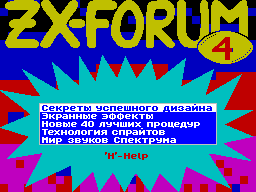|
ZX Forum #04
19 ноября 1997 |
|
world of sound Spectrum - chapter 4.3: Sound Effects - Management timbre.

4.3. Timbre control
To control the timbre of ZX-Spectrum since
did not fit as well as for management
volume. But, as the volume, it can be controlled within a small
range.
As you already know, the tone depends on the
form of sound waves. As adapted for sound shaping subroutine
Volume control is not so easy
Made of different waveforms will have to do only two levels of
volume. This can be done, for example, by using a subroutine:
1415. 10 DI; ban interrupt
20 LOOP1 LD B, 8; B = rate
30 LOOP2 XOR A; A = border color (0)
40 RLC E; scroll through the tone flag
CY
1415. 50 JR NC, NOSIGN; if the flag CY = 0, then go
on NOSIGN
60 OR 16; setting bit D4 register A
70 NOSIGN OUT (254), A; output to port A 254
80 LD D, H; D = delay
90 PAUSE DEC D; D = D-1
100 JR NZ, PAUSE; if D <> 0 then loop
110 DJNZ LOOP2; cycle rate
120 LD A, H; A = H
130 ADD A, L; add L to the A
140 LD H, A; H = A
150 DEC C; C = C-1
160 JR NZ, LOOP1; if C <> 0 then loop
170 EI; permission to interrupt
180 RET; Returns
2
Before calling this subroutine to the register C Record
length of notes in the register H - frequency, the register L -
frequency offset (subject to negative value and nil), and in
the case E - timbre. Please note that not all register values
E have meaning. Thus, at a value equal to E
255 or 0 You do not hear anything, and
Tone 1 and 128 will sound absolutely
equally, etc.
In essence, it makes sense to use
Only the following 19 tones: 1,3,5,7,9,11,
13,15,17,19,21,23,25,27,37,43,45,51 and 85.
All other values are treated similarly to hearing it.
The above program is only
example. You may well write their own,
reproducing sound with a 16-bit tone, or timbre, previously
recorded in memory to a tape inputs (see Chapter
4.6).
Other articles:
Similar articles:
В этот день... 14 December